Revision Notes for CBSE Class 11 Physics Chapter 4 (Motion in a Plane) - Free PDF Download





















FAQs on Motion in a Plane Class 11 Notes CBSE Physics Chapter 4 (Free PDF Download)
1. What are the types of motion?
Generally, all mechanical devices come with an input motion and later changes to force to produce an output motion, and the types of motion are rotary, linear, oscillating and reciprocating. Firstly, when motion takes place around an axis or a fixed joint like a wheel, it is called as rotary motion. Secondly, when motion occurs in a straight line, it is considered linear - for example, the movement of trains. Thirdly, oscillating motion can be expressed as forward and backward movement of from a fixed axis. Lastly, repeated back and forth or down and up motion is known as reciprocating motion.
2. What are the subtopics of Ch 4 Physics Class 11 Notes?
The various subtopics of class 11 Physics Ch 4 Notes are Introduction about Oscillatory Motion, Scalars and Vectors, Multiplication of Vectors with Real Numbers, Subtraction and Addition of Vectors, Resolution of Vectors, Addition of Vectors with Analytical Method, Motion in a Plane, Motion in a Plane with Constant Acceleration, 2D Relative Velocity and Uniform Circular Motion.
3. What are the laws of motion?
The three fundamental laws of motion are (i) All objects or device move in a straight or linear direction unless an external force acts upon it, (ii) Force exerted on a body is directly proportional to the mass and acceleration of the body and (iii) All actions have an equal and opposite reaction.
4. Explain whether the statement is true or false. A displacement vector is a position vector.
The given statement ‘a displacement vector is a position vector’ is true. A displacement vector provides the position or state of any point similar to the position vector. The position and displacement vector is similar to some extent. The difference between the displacement and position vector is that the displacement vector describes the position of any point concerning the other points instead of origin. While the position vector states the position of any point with respect to the origin. This is how the statement proves to be true.
5. Does the nature of any vector quantity change when it is multiplied by any scalar quantity?
The nature of a vector quantity may or may not be altered when multiplied with a scalar quantity. For instance, when a vector quantity is multiplied by any natural number like 1, 3, 6 its nature doesn’t change. On the other hand, when a scalar quantity is multiplied with a vector quantity, then the nature of vector quantity changes. For instance, when velocity (vector) is multiplied with a scalar quantity like mass, then it gives momentum, which is a quantity whose nature is different from velocity.
6. What do you mean by tensor?
Tensor is a physical quantity that doesn’t have direction. Instead, it has various values in different directions. Hence, it is neither a scalar quantity nor a vector quantity. For example, a moment of inertia of any object does not have any direction but it has various values in different directions. Thus, it is neither a scalar quantity nor a vector quantity. It is an example of a tensor. Stress, density, strain and refractive index are some other examples of tensors.
7. Explain one-dimensional motion
In 1-D motion or one-dimensional motion, only a single coordinate specifies the position of any object. In this type of motion, only one plane out of three planes describes the movement of an object with respect to the starting point or origin. Here are some examples: the motion of a car in a straight line, movement of a train in a straight line, a man cycling on a straight path, an object falling on the ground in a straight line due to the force of gravitation. If you want to understand more about motion along with some interesting examples, then visit the page NCERT Solutions for Class 11 Physics and download the solution PDF free of cost.
8. Explain two-dimensional motion.
In two-dimensional motion or 2-D motion, only two coordinates describe the position of an object. In this type of motion, only two planes out of three coordinates or planes specify the motion of the object with respect to the origin or starting point. Here are some examples: bike riding on a circular path, death well rides, an object thrown at an angle. If you want to understand different types of motions along with some exciting examples, then visit the Vedantu app.




